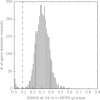A genome-scale metabolic flux model of Escherichia coli K-12 derived from the EcoCyc database
- PMID: 24974895
- PMCID: PMC4086706
- DOI: 10.1186/1752-0509-8-79
A genome-scale metabolic flux model of Escherichia coli K-12 derived from the EcoCyc database
Abstract
Background: Constraint-based models of Escherichia coli metabolic flux have played a key role in computational studies of cellular metabolism at the genome scale. We sought to develop a next-generation constraint-based E. coli model that achieved improved phenotypic prediction accuracy while being frequently updated and easy to use. We also sought to compare model predictions with experimental data to highlight open questions in E. coli biology.
Results: We present EcoCyc-18.0-GEM, a genome-scale model of the E. coli K-12 MG1655 metabolic network. The model is automatically generated from the current state of EcoCyc using the MetaFlux software, enabling the release of multiple model updates per year. EcoCyc-18.0-GEM encompasses 1445 genes, 2286 unique metabolic reactions, and 1453 unique metabolites. We demonstrate a three-part validation of the model that breaks new ground in breadth and accuracy: (i) Comparison of simulated growth in aerobic and anaerobic glucose culture with experimental results from chemostat culture and simulation results from the E. coli modeling literature. (ii) Essentiality prediction for the 1445 genes represented in the model, in which EcoCyc-18.0-GEM achieves an improved accuracy of 95.2% in predicting the growth phenotype of experimental gene knockouts. (iii) Nutrient utilization predictions under 431 different media conditions, for which the model achieves an overall accuracy of 80.7%. The model's derivation from EcoCyc enables query and visualization via the EcoCyc website, facilitating model reuse and validation by inspection. We present an extensive investigation of disagreements between EcoCyc-18.0-GEM predictions and experimental data to highlight areas of interest to E. coli modelers and experimentalists, including 70 incorrect predictions of gene essentiality on glucose, 80 incorrect predictions of gene essentiality on glycerol, and 83 incorrect predictions of nutrient utilization.
Conclusion: Significant advantages can be derived from the combination of model organism databases and flux balance modeling represented by MetaFlux. Interpretation of the EcoCyc database as a flux balance model results in a highly accurate metabolic model and provides a rigorous consistency check for information stored in the database.
Figures



References
Publication types
MeSH terms
Substances
Grants and funding
LinkOut - more resources
Full Text Sources
Other Literature Sources
Research Materials

